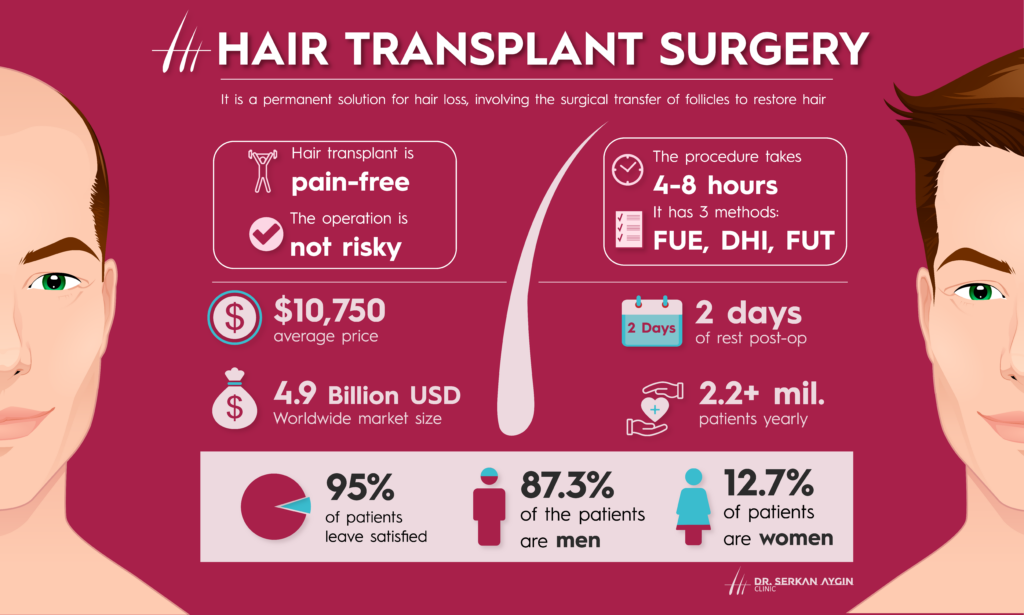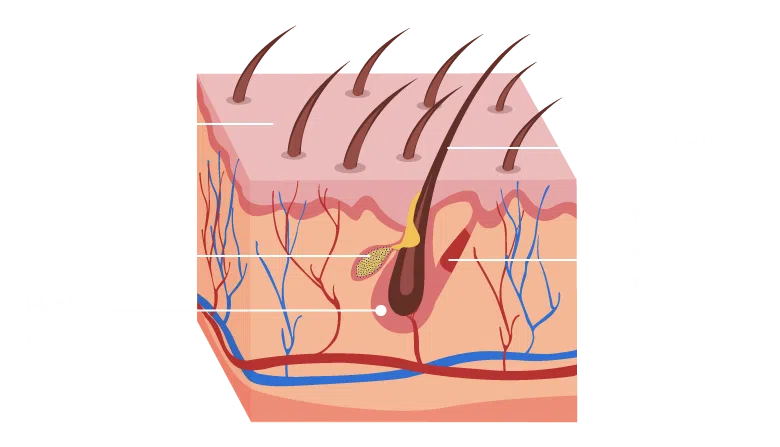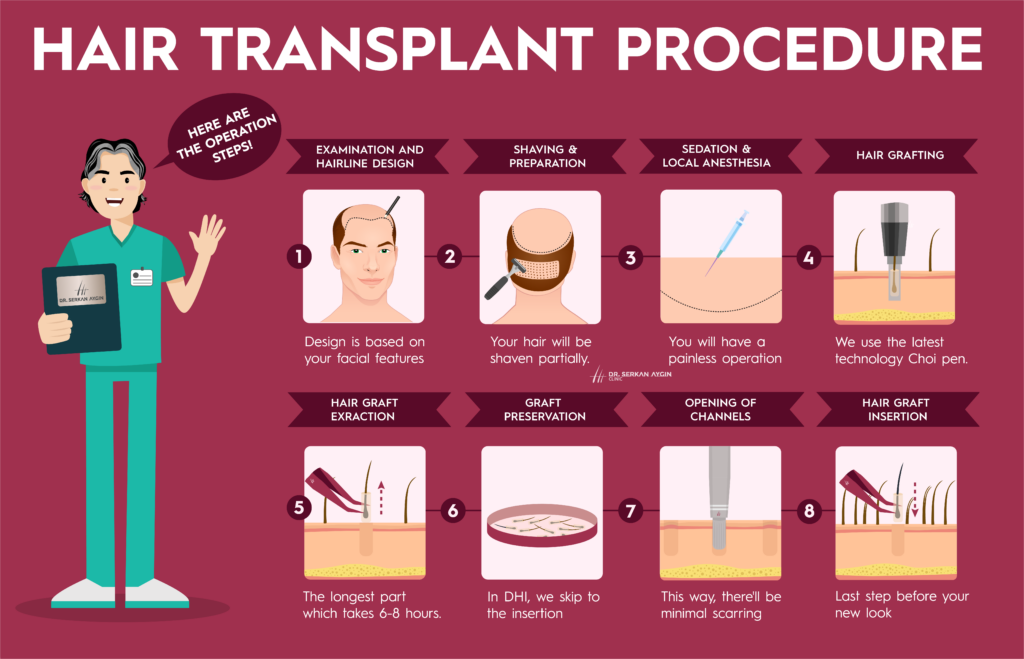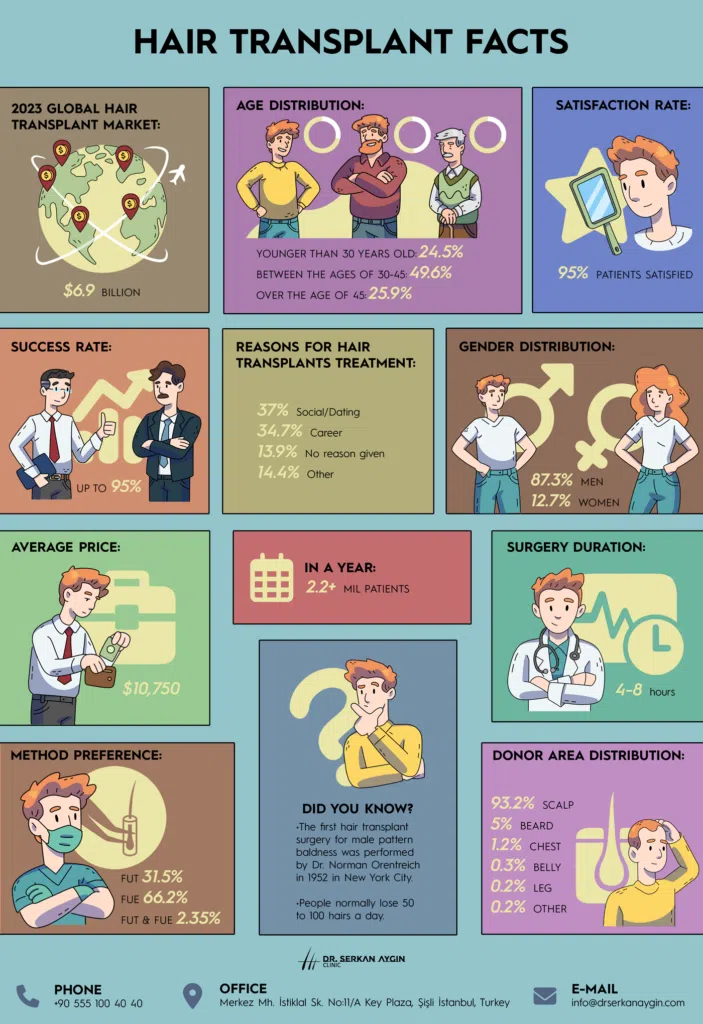Hair transplant is a surgical procedure meant to transfer the patient’s head tissue grafts (which may consist of 1 to 10 hair follicles) from the nape area to the balding or thinning area. It’s the most permanent solution to hair loss problems.
Hair transplant surgeries are becoming more common, more performed and always more requested. It’s pain-free, not risky and only uses local anesthesia.
💰 WORLWIDE 4.9 BILLION USD (2021)
✅ 95% PATIENTS SATISFIED
🏥 2.2+ MIL PATIENTS YEARLY
🚹 87.3% MEN
🚺 12.7% WOMEN
💲$10,750 AVERAGE PRICE
💤 2 DAYS OF REST POST-OP
This is the starting line for your guide. Here are some helpful key points from the article:
- HAIR TRANSPLANTATION IS THE SOLUTION FOR BALDNESS OR THINNING
- THE SURGERY IS QUICK AND PAINLESS
- THE PROCEDURE TAKES 4-8 HOURS
- THE HAIR TRANSPLANT METHODS ARE: FUE, DHI, FUT, Robotic and Stem Cell
- HAIR TRANSPLANT FOR MEN IS THE MOST COMMON
Without further ado, let’s start!
What Is a Hair Transplant?
In 2025, hair transplant surgery remains the only permanent solution to advanced baldness or hair thinning. In other words, it is the only effective treatment to reverse Androgenic Alopecia (Male Pattern Baldness). How does it work?
During the transplant procedure, the patient’s own hair follicles are transferred from dense areas into areas affected by hair loss.
A hair transplant is a hair reallocation procedure. It is not reversible and surgery lasts from 4 to 8 hours. It is performed under local anesthesia.
Up to this day, 6 main hair transplant techniques have been developed and are in use (in chronological order of appearance):

Is Hair Transplant Plastic Surgery?
Yes, hair transplantation is plastic surgery even if it’s non invasive, does not require general anesthesia and doesn’t require a stay at the hospital.
Is Hair Transplantation Serious?
If by serious you mean invasive or dangerous, no. A hair transplant is not invasive nor dangerous, yet it’s not to be taken lightly, like any surgery.
How Do Hair Implants Work?
There are two main reasons why hair transplantation works (the implantation of relocated follicles):

- Transplanting More Than Just Hair: dermatologists don’t just reallocate the hair shaft from its root. They extract and implant the whole “hair organ”. That includes surrounding tissues and all the elements that allow the survival of the hair (the sebum, erector muscle and the follicle). This allows the hair to settle in and to develop following the natural hair cycle.
- Transplanted Hair is Immune to Fall: Transplanted hair won’t fall due to Donor Dominance, making the transplanted hair immune to DHT.
What's Donor Dominance?
Donor Dominance provides the answer to the top question: is a hair transplant permanent? Yes, and Donor Dominance explains why Transplanted hair is immune to DHT (dihydrotestosterone), which is why it is not subject to androgenetic alopecia.
Testosterone has been proved to cause hair loss. The medical goal has always been to reverse hair loss without damaging testosterone production.
Won't Hair Fall Out?
No, transplanted hair won’t fall after a hair transplant because it’s not subject to DHT (dihydrotestosterone). However, your indigenous hair (the remaining hair on the bald area) may fall due to Androgenetic Alopecia, even after hair implantation.
Are Hair Transplant Results Permanent?
Yes, hair transplantation is permanent and hair transplant results remain with you forever. And if you wonder how long does a hair transplants last, it lasts for a lifetime. The transplanted hair is not subject to androgenetic alopecia. There may be some slight thinning in old age. There is over 50 years of science on the topic.
Of course, hair may still be damaged and fall due to burns, bad post-op care, accidents, temporary or seasonal hair loss, and a long etcetera.
How Long Does Surgery Last?

The procedure takes 4-8 hours, depending on how many grafts you need. Grafting a small area with less density takes less time, while grafting a large area with high hair density will take longer.
Is a Hair Transplant Safe?
Yes, hair transplantation is safe and not a risky surgery. There may be some side effects and minor risks: bleeding, allergic reaction to anesthesia, infection, and redness. However, they’re rare and easy to avoid.
The 8 Steps of the Procedure
What is the step by step procedure of a hair transplant, and how is it done? The answer varies depending on the chosen technique. Hair line design, anesthesia, follicle extraction (hair grafting) and implantation, those are the 4 steps that always take place during the procedure.
There are potentially 8 steps to a hair transplant surgery:
- CONSULTATION AND HAIRLINE DESIGN
- SHAVING & PREPARATION
- SEDATION AND LOCAL ANESTHESIA
- HAIR GRAFTING
- GRAFT PRESERVATION
- OPENING OF CHANNELS (NOT IN DHI)
- GRAFT IMPLANTATION
- POST-SURGERY

1. Consultation and Hairline Design
During initial examination, the doctor determines the main cause of hair loss, and whether the person is a suitable patient. If it is confirmed that positive results can be achieved through a hair transplant, the doctor goes on to calculate:
- How many hair grafts they can harvest
- How many grafts are needed for full hair coverage
If donor hair is fit for the surgery, the doctor will proceed to design the hairline. Advanced Clinics like Dr. Serkan Aygin‘s can employ medical 3D scanning to design an aesthetically pleasing hairline. Dr. Serkan himself supervises this step and designs 90% of his patients’ hairlines.
Don’t hesitate to contact us for a free consultation at Dr. Serkan Aygin’s.
2. Shaving & Preparation
Right before the hair transplant operation, the back of the head gets shaved to 1 to 2 mm in length. The shaving is usually like a thick line at the back of the hair, and the hair won’t be fully trimmed. It is important to have the donor hair follicles the same length for precise grafting.
- In DHI and FUE methods, this strip of shaved hair gets taken one by one with special pen tools.
- In the FUT method, that strip of hair is surgically removed, and the opened area is then sutured with stitches after grafting.
3. Sedation and Local Anesthesia
When the patient is in the operation room, surgery begins with local anesthesia and sedation applications on donor and recipient areas. Additional local anesthesia is injected into the inner corners of the brows to ease the headache during the recovery time.
Lidocaine (C14H22N2O) is usually preferred as local anesthesia. Other options include Prilocaine and Markain.
Is a Hair Transplant Done Under General Anesthesia?
No, hair transplant is not done under general anesthesia. Patients usually receive sedation through vascular access, followed by local anesthesia injections on the head.
4. Hair Grafting
During hair grafting, grafts are extracted by a micro-motor with a metal hollow pipe diameter of 0.5 to 1.0 mm. The device enters the skin by rotating and cutting it. Not only is the hair bulb extracted, but the entire follicular unit with surrounding tissue is also removed.
The operation crew follows these three basic moves until enough grafts are harvested:
- INJECTION OF MICRO MOTOR TO GRASP GRAFTS
- TWISTING AND EXTRACTING THE GRAFTS OUT
- COLLECTING THE GRAFTS WITH TWEEZERS
What If It’s a FUT Procedure?
In FUT, they surgically remove a strip of skin to harvest the hair and stitch the scalp, leaving a visible linear scar afterward. This is the infamous hair transplant scarring.
5. Graft Preservation
Hair grafts are cleaned and left in petri dishes where they must stay between 0-4 degrees cold. They are separated into different spaces, ranging from one-haired grafts to four-haired grafts so that they are ready to be loaded into the DHI pens according to their sizes.
There is no definitive data on how long hair grafts can remain outside of the body and remain viable. However, it’s preferred not to keep them out of the body for more than 2-3 hours.
6. Opening of Micro-channels (Not in DHI)
The team starts creating micro cuts with a sapphire blade in the recipient area, opening the channels that will house the harvested hair follicles. These are not deep and are very small in diameter.
The angle and the direction of these channels are key. When the team opens these channels at the perfect angle and in the right direction, the result will be natural and unnoticeable.
The key is to mimic the natural direction and angle of your hair.
7. Graft Implantation
Once the opening of the channels is completed, the grafts are inserted one by one with DHI pens. They can get loaded twice for one use, and throughout the operation, they are filled by the team simultaneously.
These are the color-to-hair number matches for a graft in the DHI Choi pen use:
Color | Size | Hair Follicle Number |
Blue | 0.8 mm | Single hair graft |
Red | 0.9 mm | Two-haired graft |
White | 1.1 mm | Three-haired graft |
Black | 1.3 mm | Four-haired graft |
8. Post-Surgery
After the hair transplant surgery, you will be able to walk, be awake and do everything. However, you may feel tired, confused and have a slight headache. We suggest you go directly home – or at the hotel – eat something and rest as much as possible. It’s absolutely normal to feel dizzy and tired. Just enjoy some rest, you deserve it!
Different Hair Transplant Techniques
Broadly speaking, we could say there are 3 different hair transplant methods. Each has subdivisions including robotic hair transplantation and stem cell hair treatments:
- FUE (FOLLICULAR UNIT EXTRACTION)
- DHI (DIRECT HAIR TRANSPLANTATION)
- FUT (FOLLICULAR UNIT TRANSPLANTATION)
FUE and DHI have the same grafting method but different insertion methods. FUT has a different extraction method but the same insertion method as FUE.
Before talking about hair transplant candidates, let’s look at the hair transplant facts together, and have some fun!

Hair Transplant Candidates
All healthy adults with common hair loss patterns benefit fruitfully from hair transplants; however, some can get it under certain conditions, while others may not qualify.
A good candidate for hair transplant has:
- AT LEAST 18 YEARS OLD
- PERMANENT HAIR LOSS
- HAIR LOSS IS SLOW
- ANDROGENIC ALOPECIA HAIR LOSS
- HAIR LOSS DUE TO TRAUMA OR BURNS
- FEMALE ANDROGENETIC ALOPECIA
- HIGH FOREHEAD
- REALISTIC EXPECTATIONS
- SUFFICIENT DONOR AREA DENSITY
- UNDERGOING GENDER TRANSITION
Not a hair transplant candidate:
- TEMPORARY HAIR LOSS
- HEPATITIS C AND BLOOD BORNE DISEASES
- PSYCHIATRIC DISORDERS OR EPILEPSY
- BLOOD INFECTIONS
- DURING CHEMOTHERAPY OR RADIOTHERAPY
- ALOPECIA AREATA (or any other kind of AUTOIMMUNE HAIR LOSS)
- HAIR LOSS DURING PREGNANCY
Men Hair Transplant
Male hair transplantations are more common with 84,2% of all hair transplants while 15,8% are females. Men are more likely to be affected by androgenetic alopecia. Also, alopecia in women is mostly diffused while in men is localized, making men better candidates for hair transplant surgery.
What About Women Hair Transplant?
Nevertheless, it doesn’t mean that women are not good candidates. Dr. Serkan Aygin’s clinic provides an in-depth look at hair transplants for women. Female hair transplants are often used to address hair loss at the hairline, temples, and mid-scalp. It is important to understand female hair loss patterns and choose experienced surgeons for optimal results.
84,2%
MEN HAIR TRANSPLANT
15,8%
WOMEN HAIR TRANSPLANT
Why Do Men Get the Operation Done?
Men undergo hair transplant mainly to remedy the effects of androgenetic alopecia which leads to a receding hairline or absence of hair in one or more areas of the head.
Androgenetic alopecia affects men exponentially more frequently than women. 67.1% in men and 23.9% in women according to some studies.
Men choose hair transplant to feel better about themselves and others. Countless studies report effects of a hair transplant on mental health and general well-being of patients.
IS HAIR TRANSPLANT SUCCESSFUL FOR MAN?
Yes, it is! A hair transplant for men has a 95% to 99% success rate. This is extremely positive.
Why Is It Important To Be A Good Candidate?
Trying to get a successful surgery is only possible when you’re a good candidate. Let’s not talk about diseases, pregnancy and psychiatric disorders for the obvious reasons.
If you get a hair transplant surgery with alopecia areata or any other autoimmune disorder causing hair loss, the transplanted hair will be attacked too and will fall permanently.
If you get hair transplant surgery when suffering from a temporary hair loss what happens? You will be wasting your time. Hair subjects to temporary hair loss are destined to grow back the moment you find out – and solve – the cause of your hair loss.
If you get a hair transplant with diffuse thinning, it will be impossible to transplant hair everywhere and determine which hair follicles are “empty” and can be filled with transplanted hair.
Can I Transplant Hair From My Son Or Another Person?
No, you cannot get hair from another person, even if they are related to you. This is because your body would reject the implanted hair, making the surgery completely useless.
There is a small catch: some studies had positive results with implantations between identical twins. However, there’s not enough evidence to pursue this kind of surgery.
Can I Use My Body Hair As Donor Area?
Yes, you can use your body hair as the donor area. Doctors usually prefer the nape area (back of the head) for collecting the grafts but that doesn’t mean it is the only way. If the hairs on your nape area are not available, your body hair can be used as a donor site.
Beard and under-chin hairs have the closest thickness and similarity to the scalp. The key point is that the body hair and the scalp hair need to have similar characteristics to be used for the procedure.
Why Would You Need A Hair Transplant?
You would need a hair transplant with any and every hair loss that’s permanent, either genetic or caused by trauma, burns, or by a birth defect. To get a hair loss treatment, your hair loss should not be auto-immune related and not in any case temporary.
Can You Get Hair Implant Surgery if Your Hair is Not Falling?
Yes, you can if:
- YOUR PERMANENT HAIR LOSS STOPPED OR SLOWED DOWN
- YOUR HAIRLINE IS TOO HIGH SINCE BIRTH
- YOU’RE UNDERGOING GENDER TRANSITIONING
- YOU LOST HAIR DUE TO BURN OR TRAUMA
What Is The Best Age?
There are no specific age limits for hair transplants. The patient must be 18+, to fully understand the implications of the transplant and make an informed decision.
However, the recommended age is generally between 22 and 75.
Between 22 and 75
Can You Get Hair Implants Too Early?
Yes, you can get a hair transplant too early if your hair loss has just started and has not settled yet. Waiting for the moment your alopecia slows down and settles is important and it will avoid multiple transplants in the future.
Do Results Look Natural?
A natural hair transplant, or better, natural looking hair transplant should be the goal of every team performing it. If the transplant is performed correctly, it will look natural and nobody will notice you got one. The team will follow the natural direction and angle of the hair and mimic it perfectly.
How To Hide The Signs of Surgery?
Not all patients are ready to immediately disclose or show their hair surgery. Here’s how to hide redness hair transplant:
- The first days: you will be in Turkey away from prying eyes. In the following days you can wear a wide-brimmed cotton hat.
- The first month: Fisherman’s hats, visor caps, bandanas, etc. They will be your allies to hide the signs of the hair transplant.
- The following months: Starting from the end of the first month you will be able to wear any type of hats. The signs of the transplant will gradually disappear and you will breathe a sigh of relief.
An unshaven, Long DHI Hair Transplant may help you hide the transplant better.
Note: We firmly believe that taking care of yourself and improving your appearance is not to be hidden but to be celebrated. There’s no shame in listening to your desires and being happy again. Either way, we understand the desire for privacy and are here to offer you helpful advice.
REFERENCES
[1] Unger WP, The History of Hair Transplantation, Hair Transplant Forum International 2000; 10(4)
[2] Beehner ML. A comparison of hair growth between follicular-unit grafts trimmed “skinny” vs. “chubby”. Dermatol Surg. 1999;25(4):339-340. doi:10.1046/j.1524-4725.1999.08262-2.x
[3] Parsley WM, Perez-Meza D. Review of factors affecting the growth and survival of follicular grafts. J Cutan Aesthet Surg. 2010;3(2):69-75. doi:10.4103/0974-2077.69014
[4] Salman KE, Altunay IK, Kucukunal NA, Cerman AA. Frequency, severity and related factors of androgenetic alopecia in dermatology outpatient clinic: hospital-based cross-sectional study in Turkey. An Bras Dermatol. 2017;92(1):35-40. doi:10.1590/abd1806-4841.20175241
[5] Park JH, Na YC, Moh JS, Lee SY, You SH. Predicting the Permanent Safe Donor Area for Hair Transplantation in Koreans with Male Pattern Baldness according to the Position of the Parietal Whorl. Arch Plast Surg. 2014;41(3):277-284. doi:10.5999/aps.2014.41.3.277
[6] Source: Wikipedia
[7] Kerure AS, Deshmukh N, Agrawal S, Patwardhan NG. Follicular Unit Extraction [FUE] – One Procedure, Many Uses. Indian Dermatol Online J. 2021;12(3):381-388. Published 2021 May 12. doi:10.4103/idoj.IDOJ_522_20
[8] ISHRS
[9] YouTube
[10] Collins K, Avram MR. Hair Transplantation and Follicular Unit Extraction. Dermatol Clin. 2021 Jul;39(3):463-478. doi: 10.1016/j.det.2021.04.003. PMID: 34053598.
[11] Ishii LE, Lee LN. Hair Transplantation: Advances in Diagnostics, Artistry, and Surgical Techniques. Facial Plast Surg Clin North Am. 2020 May;28(2):xi-xii. doi: 10.1016/j.fsc.2020.02.001. PMID: 32312512.
[12] Chouhan K, Kota RS, Kumar A, Gupta J. Assessment of Safe Donor Zone of Scalp and Beard for Follicular Unit Extraction in Indian Men: A Study of 580 Cases. J Cutan Aesthet Surg. 2019 Jan-Mar;12(1):31-35. doi: 10.4103/JCAS.JCAS_142_18. PMID: 31057266; PMCID: PMC6484564.
